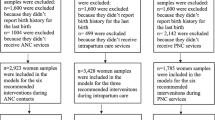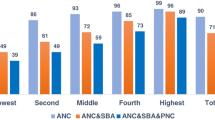Abstract
Objectives: Maternal-infant bedsharing is a common but controversial practice. Little has been published about who bedshares in the United States. This information would be useful to inform public policy, to guide clinical practice and to help focus research. The objective was to explore the prevalence and determinants of bedsharing in Oregon.
Methods. Oregon Pregnancy Risk Assessment Monitoring System (PRAMS) surveys a population-based random sample of women after a live birth. Women were asked if they shared a bed with their infant “always,” “almost always,” “sometimes” or “never.”
Results: 1867 women completed the survey in 1998–99 (73.5% weighted response rate). Of the respondents, 20.5% reported bedsharing always, 14.7% almost always, 41.4% sometimes, and 23.4% never. In multivariable logistic regression, Hispanics (adjusted odds ratio [ORa] 1.69, 95% Confidence Interval [CI] 1.17–2.43), blacks (ORa 3.11, 95% CI 2.03–4.76) and Asians/Pacific Islanders (ORa 2.14, 95% CI 1.51–3.03), women who breastfed more than 4 weeks (ORa 2.65, 95% CI 1.72–4.08), had annual family incomes less than $30,000 (ORa 2.44, 95% CI 1.44–4.15), or were single (ORa 1.55, 95% CI 1.03–2.35) were more likely to bedshare frequently (always or almost always). Among Hispanic and black women, bedsharing did not vary significantly by income level. Bedsharing black, American Indian/Alaska Native and white infants were much more likely to be exposed to smoking mothers than Hispanic or Asian/Pacific Islander infants (p < .0001).
Conclusions: Bedsharing is common in Oregon. The women most likely to bedshare are non-white, single, breastfeeding and low-income. Non-economic factors are also important, particularly among blacks and Hispanics. Campaigns to decrease bedsharing by providing cribs may have limited effectiveness if mothers are bedsharing because of cultural norms.
Similar content being viewed by others
Abbreviations
- SIDS:
-
Sudden Infant Death Syndrome
- OR:
-
odds ratio
- ORa:
-
adjusted OR
- CI:
-
Confidence Interval
- PRAMS:
-
Pregnancy Risk Assessment Monitoring System
- PNCHS:
-
Plunket National Child Health Study
- NISPS:
-
National Infant Sleep Position Study
- PHD:
-
Public Health Division
- AAP:
-
American Academy of Pediatrics
References
Anderson RN, Smith BL. Division of Vital Statistics. Deaths: Leading causes for 2002. Hyattsville, MD: National Center for Health Statistics; 2005 March 7.
Oregon Department of Human Services Health Services, Office of Disease Prevention and Epidemiology, Center for Health Statistics. Oregon Vital Statistics Annual Report 2002,Volume 2: Mortality, Fetal and Infant Mortality, Youth Suicide Attempts.
Willinger M, Ko CW, Hoffman HJ, Kessler RC, Corwin MJ. Factors associated with caregiver’s choice of infant sleep position, 1994-1998: The National Infant Sleep Position Study. JAMA 2000;283:2135–42.
American Academy of Pediatrics Task Force on Infant Sleep Position and Sudden Infant Death Syndrome. Changing concepts of sudden infant death syndrome: implications for infant sleeping environment and sleep position. Pediatrics 2000;105:650–6.
Nakamura S, Wind M, Danello MA. Review of hazards associated with children placed in adult beds. Arch Pediatr Adolesc Med 1999;53:1019–23.
Drago DA, Dannenberg AL. Infant mechanical suffocation deaths in the United States, 1980–1997. Pediatrics 1999;103:e59. http://www.pediatrics.org/cgi/content/full/103/5/e59 Accessed 11/1/05.
American Academy of Pediatrics Task Force on Sudden Infant Death Syndrome. The changing concept of Sudden Infant Death Syndrome: diagnostic coding shifts, controversies regarding the sleeping environment, and new variables to consider in reducing risk. Pediatrics 2005;116:1245–55. http://pediatrics.aappublications.org/cgi/content/full/peds.2005-1499v1. Accessed 11/1/05.
Rosenberg KD. Sudden infant death syndrome and co-sleeping. Arch Pediatr Adolesc Med 2000;154:529.
McAfee T. Bed sharing is not a “consumer product”. Arch Pediatr Adolesc Med 2000;154:530–1.
Ball HL, Blair PS, Ward-Platt MP. “New” practice of bedsharing and risk of SIDS. Lancet 2004;363:1558.
Lahr MB, Rosenberg KD, Lapidus JA. Bedsharing and maternal smoking in a population-based survey of new mothers. Pediatrics 2005;116:e530–42. http://pediatrics.aappublications.org/cgi/reprint/116/4/e530. Accessed 11/1/05.
Department of Human Services, Health Services. Oregon PRAMS First Year Report, 1998–99. Portland, Oregon: Office of Family Health, 2000. http://oregon.gov/DHS/ph/pnh/prams/9899/ar9899.shtml#citat. Accessed 11/1/05.
Hodge JG, Gostin LO, with the CSTE Advisory Committee. Public Health Practice vs. Research: A Report for Public Health Practitioners Including Cases and Guidance for Making Distinctions. Atlanta, GA: Council of State and Territorial Epidemiologists; 2004. Available at: www.cste.org/pdffiles/newpdffiles/CSTEPHResRptHodgeFinal.5.24.04.pdf. Accessed 11/1/05.
Willinger M, Ko C-W, Hoffman HJ, Kessler RC, Corwin MJ. Trends in infant bed sharing in the United States, 1993–2000: The National Infant Sleep Position Study. Arch Pediatr Adolesc Med 2003;157:43–9.
Tuohy PG, Counsell AM, Geddis DC. Sociodemographic factors associated with sleeping position and location. Arch Dis Child 1993;69:664–6.
Blair PS, Ball HL. The prevalence and characteristics associated with parent-infant bed-sharing in England. Arch Dis Child 2004;89:1106–1110.
Flick L, White DK, Vemulapalli C, Stulac BB, Kemp JS. Sleep position and the use of soft bedding during bed sharing among African American infants at increased risk for sudden infant death syndrome. J Pediatr 2001;138:338–43.
Vemulapalli C, Grady K, Kemp JS. Use of safe cribs and bedroom size among African American infants with a high rate of bed sharing. Arch Pediatr Adolesc Med 2004;158:286–9.
Lozoff B, Wolf AW, Davis NS. Cosleeping in urban families with young children in the United States. Pediatrics 1984;74:171–182.
Brenner RA, Simons-Morton BG, Bhaskar BS, Mehta N, Melnick VL, Ravenis M, et al. Prevalence and predictors of the prone sleep position among inner-city infants. JAMA 1998;280:341–6.
Brenner RA, Simons-Morton BG, Bhaskar B, Revenis M, Das A, Clemens JD. Infant-parent bed sharing in an inner-city population. Arch Pediatr Adolesc Med 2003;157:33–9.
Scragg LK, Mitchell EA, Tonkin SL, Hassall IB. Evaluation of the cot death prevention programme in South Auckland. N Z Med J 1993;106:8–10.
Rice PL, Naksook C. Child rearing and cultural beliefs and practices amongst Thai mothers in Victoria, Australia: Implications for the sudden infant death syndrome. J Paediatr Child Health 1998;34:320–4.
Lutz S, Wolf AW, Lozoff B. Cosleeping in context: sleep practices and problems in young children in Japan and the United States. Arch Pediatr Adolesc Med 1999;153:339–46.
Yang C-K, Hahn H-M. Cosleeping in young Korean children. J Dev Behav Pediatr 2002;23:151–7.
Panaretto KS, Smallwood VE, Cole P, Elston J, Whitehall JS. Sudden infant death syndrome risk factors in north Queensland: A survey of infant-care practices in Indigenous and non-Indigenous women. J Paediatr Child Health 2002;38:129–34.
Lee NNY, Chan YF, Davies DP, Lau E, Yip DCP. Sudden infant death syndrome in Hong Kong: confirmation of low incidence. Br Med J 1989;298:721.
Nelson EAS, Chan PH. Child care practices and cot death in Hong Kong. N Z Med J 1996;109:144–6.
Nelson EAS, Taylor BJ. International Child Care Practices Study: infant sleep position and parental smoking. Early Hum Dev 2001;64:7–20.
Farooqi IS, Lip GYH, Beevers DG. Bed sharing and smoking in the sudden infant death syndrome. Brit Med J 1994;308:204–205.
Ball HL. Reasons to bed-share: why parents sleep with their infants. J Reprod Infant Psychol 2002;207–21.
Ball HL. Breastfeeding, bed-sharing, and infant sleep. Birth 2003;30:181–8.
American Academy of Pediatrics Section on Breastfeeding. Breastfeeding and the use of human milk: AAP Section on Breastfeeding. Pediatrics 2005;115:496–506.
Ford RPK, Mitchell EA, Scragg R, Stewart AW, Taylor BJ, Allen EM. Factors adversely associated with breast feeding in New Zealand. J Paediatr Child Health 1994;30:483–9.
McKenna JJ, Mosko Ss, Richard Ca. Bedsharing promotes breastfeeding. Pediatrics 1997;100:214–9.
Mosko S, Richard C, McKenna J. Infant arousals during mother-infant bed sharing: implications for infant sleep and sudden infant death syndrome research. Pediatrics 1997;100:841–9.
Kraus JF, Greenland S, Bulterys M. Risk Factors for sudden infant death syndrome in the US collaborative perinatal project. Int J Epidemiol 1989;18:113–20.
Ponsonby A-L, Dwyer T, Kasl SV, Cochrane JA. The Tasmanian SIDS case-control study: univariable and multivariable risk factor analysis. Paediatr Perinat Epidemiol 1995;9:256–72.
Gilbert RE, Wigfield RE, Fleming PJ, Berry PJ, Rudd PT. Bottle feeding and the sudden infant death syndrome. Br Med J 1995;310:88–90.
Mitchell EA, Tuohy PG, Brunt JM, Thompson JMD, Clements MS, Stewart AW, et al. Risk factors for sudden infant death syndrome following the prevention campaign in New Zealand: a prospective study. Pediatrics 1997;100:835–40.
Scragg RKR, Mitchell EA, Stewart AW, Ford RPK, Taylor BJ, Hassall IB, et al. Infant room-sharing and prone sleep position in sudden infant death syndrome. Lancet 1996;347:7–12.
Klonoff-Cohen H, Edelstein SL. Bed sharing and the sudden infant death syndrome. Br Med J 1995;311:1269–72.
Fleming PJ, Blair PS, Bacon C, Bensley D, Smith I, Taylor E, et al. Environment of infants during sleep and risk of the sudden infant death syndrome: results of 1993-5 case-control study for confidential inquiry into stillbirths and deaths in infancy. Br Med J 1996;313:191–5.
Blair PS, Fleming PJ, Smith IJ, Platt MW, Young J, Nadin P, et al. Babies sleeping with parents: case-control study of factors influencing the risk of sudden infant death syndrome. Br Med J 1999;319:1457–62.
Hauck FR, Herman SM, Donovan M, Iyasu S, Moore CM, Donoghue E, et al. Sleep environment and the risk of Sudden Infant Death Syndrome in an urban population: The Chicago Infant Mortality Study. Pediatrics 2003;111:1207–14.
Tappin D, Brooke H, Ecob R, Gibson A. Used infant mattresses and sudden infant death syndrome in Scotland: case-control study. Br Med J 2002;325:1–6. http://bmj.com/cgi/reprint/325/7371/1007.pdf Accessed 11/1/05.
McGarvey C, McDonnell M, Chong A, O’Regan M, Matthews T. Factors relating to the infant’s last sleep environment in sudden infant death syndrome in the Republic of Ireland. Arch Dis Child 2003;88:1058–64.
Brooke H, Gibson A, Tappin D, Brown H. Case control study of sudden infant death syndrome in Scotland, 1992-1995. Br Med J 1997;314:1516–20.
Carpenter RG, Irgens LM, Blair PS, England PD, Fleming P, Huber J, et al. Sudden unexplained infant death in 20 regions in Europe: case control study. Lancet 2004;363:185–91.
Tappin D, Ecob R, Brooke H. Bedsharing, roomsharing, and Sudden Infant Death Syndrome in Scotland: a case-control study. J Pediatr 2005;147:32–7.
McGarvey C, McDonnell M, Hamilton K, O’Regan M, Matthews T. An eight-year study of risk factors for SIDS: Bedsharing vs. non bed-sharing. Arch Dis Child 2005 (doi:10.1136/adc.2005.074674):1–7. http://adc.bmjjournals.com/cgi/content/abstract/adc.2005.074674v1. Accessed 11/1/05.
Vennemann MMT, Findeisen M, Butterfaß-Bahloul T, Jorch G, Brinkmann B, Köpcke W, et. al. Modifiable risk factors for SIDS in Germany: Results of GeSID. Acta Pædiatrica 2005;94:655–60.
Hooker E, Ball HL, Kelly PJ. Sleeping like a baby: attitudes and experiences of bedsharing in Northeast England. Med Anthropol 2001;19:203–22.
Ball HL, Hooker E, Kelly PJ. Where will the baby sleep? Attitudes and practices of new and experienced parents regarding cosleeping with their newborn infants. Am Anthropol 1999;101:143–51.
Acknowledgments
The authors thank Tina Kent for her work on Oregon PRAMS, and Alfredo P. Sandoval, MBA, MS, for his preparation of the PRAMS/birth certificate data set. Some funding for Oregon PRAMS has come from the Maternal and Child Health Bureau-Health Resources and Services Administration and the Centers for Disease Control and Prevention of the U.S. Department of Health and Human Services.
Author information
Authors and Affiliations
Corresponding author
Rights and permissions
About this article
Cite this article
Lahr, M.B., Rosenberg, K.D. & Lapidus, J.A. Maternal-Infant Bedsharing: Risk Factors for Bedsharing in a Population-Based Survey of New Mothers and Implications for SIDS Risk Reduction. Matern Child Health J 11, 277–286 (2007). https://doi.org/10.1007/s10995-006-0166-z
Received:
Accepted:
Published:
Issue Date:
DOI: https://doi.org/10.1007/s10995-006-0166-z




